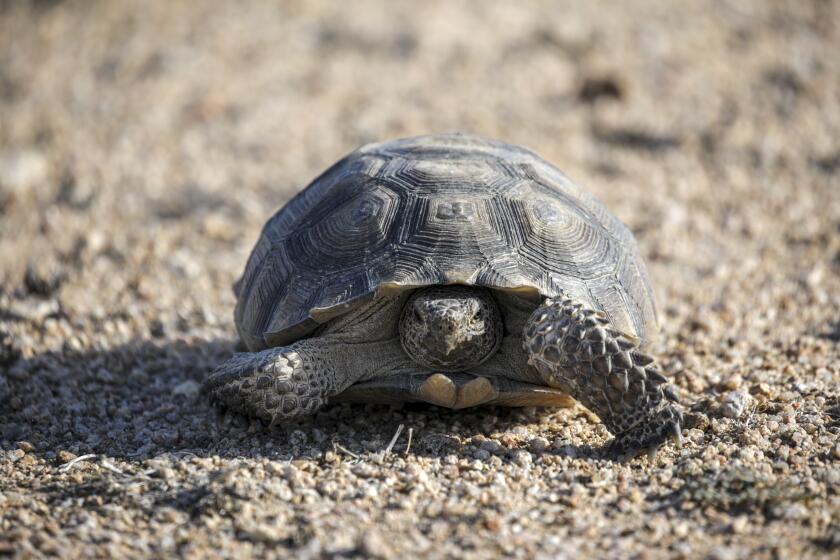Mojave desert tortoise officially joins California’s endangered list

- Share via
The California Fish and Game Commission has formally recognized the Mojave desert tortoise as endangered.
The designation, granted Thursday, is the latest in a long series of steps to try to protect the dwindling population of the desert creature, which biologists say is heading toward extinction.
The tortoise was designated as threatened under the California Endangered Species Act in 1989 and as threatened under the Endangered Species Act in 1990. In 2020, Defenders of Wildlife, Desert Tortoise Council and Desert Tortoise Preserve petitioned to change the tortoise’s status to endangered, which would give it higher priority and funding for conservation measures such as habitat protection and recovery efforts.
The commission then granted temporary endangered species to the desert tortoise while it considered adding it permanently to the list.
A recovery plan was created in 1994, and then revised in 2011 after there were issues implementing the recovery strategies.
Between 2001 and 2020, population densities in tortoise conservation areas went down by an average of 1% per year in the Colorado Desert and Eastern Mojave Recovery units, according to a February 2024 California Department of Fish and Wildlife report.
The minimum density for the tortoises to remain viable is 3.9 adults per square kilometer, according to the report. Only 2 out of the 10 designated tortoise conservation areas currently meet that threshold.
The desert tortoise is teetering on the brink of extinction. Can California’s Endangered Species Act save it from oblivion?
About 1 million animal and plant species are at risk of being endangered — more than ever in human history, according to a recent report from the Intergovernmental Science-Policy Platform on Biodiversity and Ecosystem Services.
The abundance of native species in land habitats has decreased by about 20% since 1900, according to the report. More than 40% of amphibian species, nearly 33% of reef-forming corals and more than a third of marine animals are threatened.
Sadly, California’s state reptile — formally Gopherus agassizii — is hurtling toward extinction. Vehicle strikes, urban encroachment, hungry ravens, military maneuvers, disease, drought, extreme heat, wildfires, illegal marijuana grows and development of massive solar farms are all pushing the species to the brink.
The tortoises live in the rocky foothills north and west of the Colorado River in California, Arizona, Utah and Nevada. They feed on grasses, cacti, herbs and wildflowers.
They hibernate for up to nine months each year and are most active from March to June and September to October. The sleep pays a longevity dividend — the tortoises can live for 50 to 80 years.
More to Read
Sign up for Essential California
The most important California stories and recommendations in your inbox every morning.
You may occasionally receive promotional content from the Los Angeles Times.















